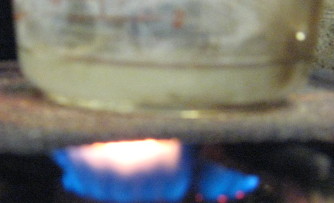nice to understand, in a futur video i will show how to make pur sulution of H2TiCl6,or H2TiF6 a way you could use :
first get titanium piece.
than disolve man exxess of titanium in 9% hydrochloric acid with refux ((very long) or in 9% hydrofluoric acid:very dangerous:If you arent a
experienced chemist dont do that)
you could make it safely from this way(take all safety gear): take a 100ml steel paint can with a steel or copper tube as condencer witch will go in a
120 ml hdpe bottle. take 21g of NaF with 60g of NaHSO4(an exess is better) and disolve it in 60ml of water outside in the steel can, pour 40ml of
water in the hdpe bottle (make sur that the condenser go in the water) and make and snow/HCl bath for the bottle.Than distill the solution of NaF in
the steel retort(like if you distil HCl ). go away from the set up . after that take the hdpe bottle and you have arround 8-10%HF solution.
when you ave your TiCl3 or fluoro complex you can fallow this guide from:
1=TiCl3
2=fluoro complex
1-1 take the TiCl3 and ad very large ammount of ammonia , filter the hydroxide it dont affect the finnal product if it disproportionate to hydrous
titanium dioxide , it will just be more long to react.
1-2take the fluoro complex and ad very large ammount of ammonia , filter the hydroxide it dont affect the finnal product if it disproportionate to
hydrous titanium dioxide , it will just be more long to react.
2-1ad the minimum amount you can of 9% HCl to the hydroxide a pale clear yelow solution will form.
2-2ad the minimum amount you can of 9% HF to the hydroxide a clear solution will form.
why all the time i sayd to use 9% is because i find it react more readily than other conssentration. for your camping pot you will probably need to
cut it in piece (very difficult). also you can make very conssentred solution by boiling it to 1/4 of is volume.
with this 2 solution you can make almost all compound of titanium.
[Edited on 10-3-2011 by plante1999]
[Edited on 10-3-2011 by plante1999] |











